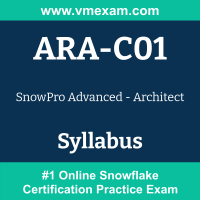 The Snowflake ARA-C01 exam preparation guide is designed to provide candidates with necessary information about the SnowPro Advanced - Architect exam. It includes exam summary, sample questions, practice test, objectives and ways to interpret the exam objectives to enable candidates to assess the types of questions-answers that may be asked during the Snowflake Certified SnowPro Advanced - Architect exam.
The Snowflake ARA-C01 exam preparation guide is designed to provide candidates with necessary information about the SnowPro Advanced - Architect exam. It includes exam summary, sample questions, practice test, objectives and ways to interpret the exam objectives to enable candidates to assess the types of questions-answers that may be asked during the Snowflake Certified SnowPro Advanced - Architect exam.
It is recommended for all the candidates to refer the ARA-C01 objectives and sample questions provided in this preparation guide. The Snowflake SnowPro Advanced - Architect certification is mainly targeted to the candidates who want to build their career in Advance domain and demonstrate their expertise. We suggest you to use practice exam listed in this cert guide to get used to with exam environment and identify the knowledge areas where you need more work prior to taking the actual Snowflake SnowPro Advanced - Architect exam.
Snowflake ARA-C01 Exam Summary:
| Exam Name | Snowflake SnowPro Advanced - Architect |
| Exam Code | ARA-C01 |
| Exam Price | $375 USD |
| Duration | 115 minutes |
| Number of Questions | 65 |
| Passing Score | 750 + Scaled Scoring from 0 - 1000 |
| Recommended Training / Books |
Snowflake Architect Training SnowPro Advanced: Architect Study Guide |
| Schedule Exam | PEARSON VUE |
| Sample Questions | Snowflake ARA-C01 Sample Questions |
| Recommended Practice | Snowflake Certified SnowPro Advanced - Architect Practice Test |
Snowflake SnowPro Advanced - Architect Syllabus:
| Section | Objectives |
|---|---|
Accounts and Security - 25% |
|
| Design a Snowflake account and database strategy, based on business requirements. |
- Create and configure Snowflake parameters based on a central account and any additional accounts.
- List the benefits and limitations of one Snowflake account as compared to multiple Snowflake accounts.
|
| Design an architecture that meets data security, privacy, compliance, and governance requirements. |
- Configure Role-Based Access Control (RBAC) hierarchy
- Data Access
- Data Security
|
| Outline Snowflake security principles and identify use cases where they should be applied. |
- Encryption - Network security
- User, role, and grants provisioning
|
Snowflake Architecture - 30% |
|
| Outline the benefits and limitations of various data models in a Snowflake environment. |
- Data models
- Use of key/column constraints (ENABLE/RELY/VALIDATE) |
| Design data sharing solutions, based on different use cases. |
- Use cases
- Snowflake Marketplace
|
| Create architecture solutions that support development lifecycles as well as workload requirements. |
- Data lake and environments
- Development lifecycle support
- Outline basic AI/ML pipelines and applications
|
| Given a scenario, outline how objects exist within the Snowflake object hierarchy and how the hierarchy impacts an architecture. |
- Roles - Virtual warehouses - Object hierarchy
|
| Determine the appropriate data recovery solution in Snowflake and how data can be restored. |
- Backup/recovery
- Disaster recovery
|
Data Engineering - 25% |
|
| Determine the appropriate data loading or data unloading solution to meet business needs. |
- Data sources
- Data ingestion
- Architecture changes
- Data unloading |
| Outline key tools in Snowflake’s ecosystem and how they interact with Snowflake. |
- Connectors
- Drivers
- API endpoints
- SnowSQL
|
| Determine the appropriate data transformation solution to meet business needs. |
- Views and tables
- Staging layers and tables
- Data processing
|
Performance Optimization - 20% |
|
| Outline performance tools, best practices, and appropriate scenarios where they should be applied. |
- Query profiling
- Virtual warehouse configurations
- Clustering
- Search optimization service
|
| Troubleshoot performance issues with existing architectures. |
- Use of system clustering information - Warehouse monitoring - Optimization techniques - Micro-partition pruning - Monitoring and alerting
|
